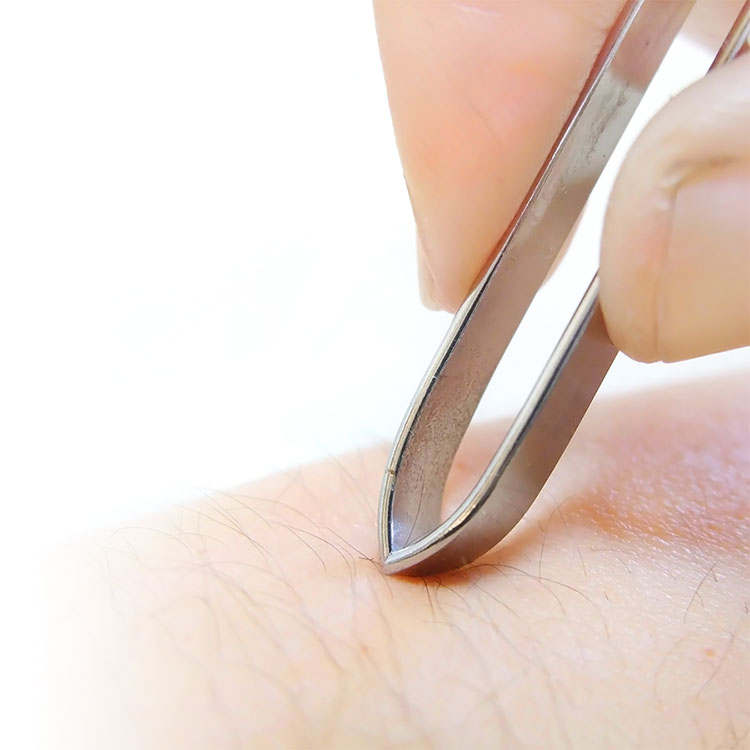An ingrown hair is a hair that grows under the skin and not at the surface. Here is some information to avoid the unpleasantness of ingrown hairs.
What is an ingrown hair?
An ingrown hair occurs when a hair curls back and grows under the skin instead of piercing it and growing outside of it. This causes the appearance of a small red and inflamed bump where the hair should normally come out of the skin.
Most of the time, the problem caused by an ingrown hair is esthetic. However, ingrown hairs can cause irritation and unpleasant itching, and sometimes, even pain. In some cases, they can also become infected. An ingrown hair can also leave a scar, especially if it has been scratched.
Although it can appear anywhere on the body where hair grows, ingrown hairs occur primarily in areas that are subject to shaving or waxing, such as the face and neck in men. In women, they often occur on the legs, pubic area, groin, and armpits.
What are the causes and risk factors?
People who shave or wax are likely to have ingrown hairs. Although anyone can get them, they are more likely to occur if your hair is curly or thick. Curly hair tends to curl back under the skin. Individuals with a lot of hair growth or who have coarse skin are also more at risk.
Moreover, the accumulation of dead skin cells due to a lack of exfoliation can promote ingrown hairs. Very dry skin also makes it more difficult for hair to pierce the skin. Additionally, cleaning skin with harsh products or rubbing it vigorously can cause irritation, fostering the occurrence of ingrown hairs.
While these factors increase the risk, the main cause of ingrown hairs is improper shaving or waxing techniques.
How can ingrown hairs be prevented?
Preventing ingrown hairs is mainly a matter of proper skin care and good shaving or hair removal techniques. Here are some practical tips:
- Exfoliate and moisturize your skin regularly.
- Practise good hygiene. Clean your skin with a mild soap as well as your shaving equipment (e.g., razor blades) or epilator head before using them.
- If shaving or waxing cannot be avoided, space out sessions as much as possible. Give your skin a break whenever possible.
- When shaving, use a razor with a single blade. Multi-blade razors cut the hair under the skin, which can lead to ingrown hairs.
- Wet the skin with warm water and apply a shaving gel or cream before shaving.
- When shaving, glide the razor in the direction of the hair growth and not in the opposite direction.
- Glide the razor as few times as possible over the same area. The more times you shave over the same spot, the more the hairs are likely to curl back under the skin.
- Rinse the razor blade after each stroke.
- If you do your own waxing or have it done by a professional, consider changing the method you use. Several techniques exist—electric epilator, warm wax (with strips), sugar wax, etc. Choose the method that works best for you and is least likely to cause ingrown hairs.
- If possible, use a depilatory cream instead of a razor to eliminate unwanted hair. The best-case scenario is to use a permanent hair removal technique such as laser or electrolysis to get rid of ingrown hairs permanently.
How should ingrown hairs be treated?
If you notice ingrown hairs despite applying the above-mentioned prevention techniques, don’t despair! They often disappear on their own. A gentle exfoliation can help the hair to pierce the skin on its own. It is important not to fiddle with the skin to try to get the hair out, as this increases the risk of irritation and infection. Don’t use your fingernails, tweezers or a needle. Some estheticians know how to remove an ingrown hair, but be careful. It requires expertise and especially, the use of sterile equipment.
If an ingrown hair persists, becomes infected or forms a cyst, it is best to consult a healthcare professional such as a doctor or dermatologist. A small procedure can be done to remove the hair, such as using a sterile needle. In some cases, a topical or oral antibiotic may be necessary if the ingrown hair is infected.
Other treatments can also help reduce irritation and inflammation associated with ingrown hairs, such as cortisone creams. If you're not sure what to do to prevent or treat ingrown hairs, don’t hesitate to speak to your pharmacist, who can recommend over-the-counter products or refer you to a doctor if needed.
As you can see, there are many ways to deal with ingrown hairs, so don’t let it rub you the wrong way and prepare for battle against ingrown hairs!

